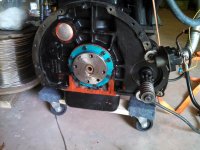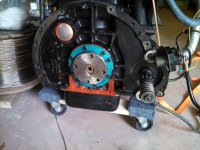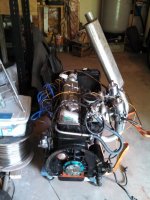I Just installed the Alexander seal and it was really easy. A couple of tips:
1. Don't try to open the spring. Remove it from the lip and work it gently over the crank boss. Then open the viton part and slip it over the crank boss so the lip of the seal faces the spring.
Lastly (I have a little hook tool) position the spring back into place. Oil up the lip.
2. Light coating of silicon seal around the seal and in the split. Mark the split position on the crank with a felt tip. Position the crank in place seal split facing cylinder head, By tightening the bearing cap bolts, move the rear bearing cap til its almost down but don't tighten yet
Hand tighten the flywheel bolts (without the flywheel) till the bolt ends move the seal into place. Don't overtighten, it does not take much to move the seal.
Torque down the cap (85-90 lb-ft) and without turning the crank, let it stand overnight.
Naturally all the other instructions hold. Make sure you have the correct flywheel bolts when you install the flywheel. If they are too long, it will wipe out the seal as soon as the crank turns. Mine measured 23 mm long
You can buy the whole kit from Joe Alexander (the-vintage-racer.com) including the centering tool. Loved it.
Update 8/20/15 Got the motor running on the bench. I Ran it for 1/2 hour and pulled the flywheel. Rear Seal has absolutely no leaks. Some seeping from pan gasket in front which I am going to attend to. Do be careful of the flywheel/crank bolts. Without the lock plate, they will hit the seal. Moss sells self-locking bolts which are a hair shorter. Note the abundance of Red Silicone. Belts and Suspenders

 Hi Guest!
Hi Guest!

 smilie in place of the real @
smilie in place of the real @
 Pretty Please - add it to our Events forum(s) and add to the calendar! >>
Pretty Please - add it to our Events forum(s) and add to the calendar! >> 



